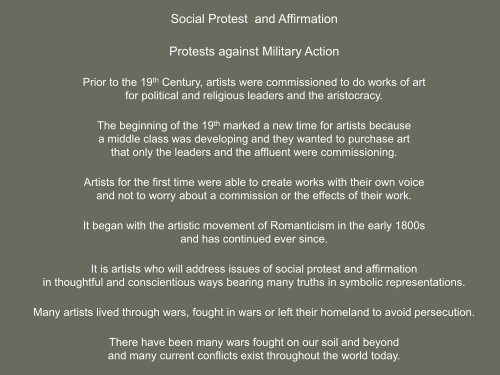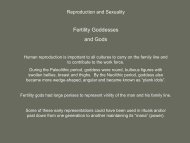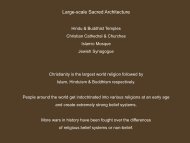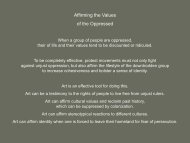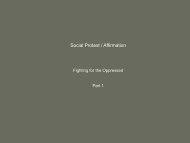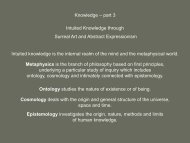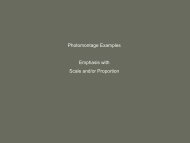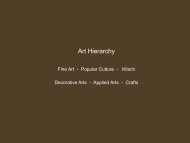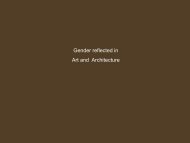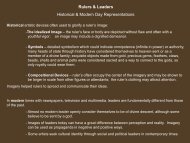Social Protest and Affirmation Protests against Military Action
Protests against military action - Visual Art Notes - Home
Protests against military action - Visual Art Notes - Home
- No tags were found...
You also want an ePaper? Increase the reach of your titles
YUMPU automatically turns print PDFs into web optimized ePapers that Google loves.
<strong>Social</strong> <strong>Protest</strong> <strong>and</strong> <strong>Affirmation</strong><br />
<strong>Protest</strong>s <strong>against</strong> <strong>Military</strong> <strong>Action</strong><br />
Prior to the 19 th Century, artists were commissioned to do works of art<br />
for political <strong>and</strong> religious leaders <strong>and</strong> the aristocracy.<br />
The beginning of the 19 th marked a new time for artists because<br />
a middle class was developing <strong>and</strong> they wanted to purchase art<br />
that only the leaders <strong>and</strong> the affluent were commissioning.<br />
Artists for the first time were able to create works with their own voice<br />
<strong>and</strong> not to worry about a commission or the effects of their work.<br />
It began with the artistic movement of Romanticism in the early 1800s<br />
<strong>and</strong> has continued ever since.<br />
It is artists who will address issues of social protest <strong>and</strong> affirmation<br />
in thoughtful <strong>and</strong> conscientious ways bearing many truths in symbolic representations.<br />
Many artists lived through wars, fought in wars or left their homel<strong>and</strong> to avoid persecution.<br />
There have been many wars fought on our soil <strong>and</strong> beyond<br />
<strong>and</strong> many current conflicts exist throughout the world today.
The Second of May 1808<br />
The Charge of the Mamelukes<br />
1814 Oil 8’ 27”x 11’ 13”<br />
There have been many wars fought between<br />
the French <strong>and</strong> the Spanish. Here are a few:<br />
French Wars of Religion 1562-1598<br />
Franco-Spanish War 1635-1659<br />
War of the Spanish Succession 1701-1714<br />
War of the Pyrenees 1793-1795<br />
The Peninsular War 1807-1814<br />
The Napoleonic Wars 1803-1815<br />
These two paintings by Romanticist,<br />
Francisco de Goya in 1814 about the<br />
rebellion of the people of Madrid <strong>against</strong><br />
French occupation, which triggered the<br />
Peninsular War.<br />
The Third of May 1808<br />
1814 oil 8’ 9” x 13’ 4”
Expressionist, Käthe Kollwitz<br />
lived through two wars <strong>and</strong><br />
lost a son <strong>and</strong> a gr<strong>and</strong>son to war.<br />
Her images express universal symbols<br />
about inhumanity, injustices <strong>and</strong><br />
humankind’s destruction of itself.<br />
The Prisoners 1908 etching<br />
The Outbreak 1903 etching<br />
#5 from the series The Peasant’s War
Käthe Kollwitz<br />
Conspiracy 1898<br />
lithograph<br />
Never Again War 1924
John Heartfield<br />
Goering the Executioner<br />
9/13/1933<br />
Goering was a hated man <strong>and</strong> at one time<br />
was second in comm<strong>and</strong> to Hitler.<br />
Goering started the SS Gestapo <strong>and</strong> many<br />
saw Goering as the one who saw through<br />
the Jewish Holocaust during WWII.<br />
Heartfield was on the run after this magazine<br />
cover was published.
Pablo Picasso painted Guernica in response to the bombing of this northern Spain village in the<br />
Basque region by German <strong>and</strong> Italian warplanes at the behest of General Franco <strong>and</strong> the<br />
Spanish Nationalist forces on April 26, 1937 during the Spanish Civil War. Many women <strong>and</strong><br />
children were killed. Men were off in war.<br />
Pablo Picasso<br />
Guernica<br />
1937 Oil 25.5’ x 11.5’
David Alfaro Siqueiros<br />
Echo of a Scream<br />
1937<br />
Enamel on wood 48” x 36”<br />
As an outspoken Communist in Mexico,<br />
Siqueiros joined revolutionary efforts <strong>and</strong><br />
painted emotional depictions of strife <strong>and</strong><br />
anguish of the Mexican people as they<br />
fought for independence.<br />
In thinking about war,<br />
do children come to your mind?
David Alfaro Siqueiros<br />
The Revolutionaries<br />
from the Dictatorship of Portirio Diaz to the Revolution 1957-1965<br />
Hall of the Revolution, National History Museum, Mexico City
La Marcha de la Humanidad<br />
David Alfaro Siqueiros<br />
Del porfirismo al la Revolucion 1957-1965
Shōmei Tōmatsu<br />
Woman with Keloidal Scars<br />
Hiroshima–Nagasaki Document 1961<br />
photograph 11 ½” x 16”<br />
Tōmatsu photographed survivors of the atomic bombings dropped on their cities in 1945<br />
by the United States. These two events are the only use of nuclear weapons in war to date.
Bomb <strong>and</strong> Victims<br />
Search <strong>and</strong> Destroy<br />
Effected by the daily<br />
images seen on<br />
television during the<br />
Vietnam War, Nancy<br />
Spero painted<br />
War Series 1965-1969.<br />
These small gouache<br />
<strong>and</strong> inks on paper<br />
drawings, executed<br />
rapidly, represented the<br />
obscenity <strong>and</strong><br />
destruction of war.<br />
The War Series is<br />
among the most<br />
sustained <strong>and</strong> powerful<br />
group of works in the<br />
genre of history<br />
painting that condemns<br />
war <strong>and</strong> its real <strong>and</strong><br />
lasting consequences.<br />
Victims<br />
Eagles, Swastikas <strong>and</strong> Victims<br />
Images from War Series 1965 –1968
Leon Golub Mercenaries 1976 acrylic<br />
Golub’s large-scale works were often pulled directly from a huge database he assembled of journalistic images<br />
from the mass media. Early series include Napalm <strong>and</strong> Vietnam. In the 1980s, Golub turned his attention to<br />
terrorism in a variety of forms, from the subversive operations of governments to urban street violence.<br />
Among the work produced in this period are the series Mercenaries, Interrogation, Riot, <strong>and</strong> Horsing Around.
Leon Golub<br />
Interrogation III 1981 Interrogation II 1981<br />
Killing fields, torture chambers, bars, <strong>and</strong> brothels became inspiration <strong>and</strong> subject<br />
for work that dealt with such themes as violent aggression, racial inequality, gender<br />
ambiguity, oppression, <strong>and</strong> exclusion.<br />
Interrogation was another series by Golub
Leon Golub working in his studio.
A well-known photograph from 1967 of students in front of military police on<br />
a college campus protesting the use of violence in Vietnam.<br />
Bernie Boston<br />
Flower Power 1967
Pop artist James Rosenquist<br />
took as his subject the F-111<br />
fighter bomber plane, the<br />
newest, most technologically<br />
advanced weapon in<br />
development at the time, <strong>and</strong><br />
positioned it, as he later<br />
explained, “flying through the<br />
flak of consumer society to<br />
question the collusion<br />
between the Vietnam death<br />
machine, consumerism, the<br />
media, <strong>and</strong> advertising.”<br />
F-111<br />
1965 23 panels oil on aluminum 10’ x 86’
James Rosenquist<br />
F-111<br />
1965<br />
one<br />
continuous panel<br />
10’ h x 86’ l
James Rosenquist<br />
Other example of consumer products as military weaponry.<br />
Maybe Rosenquist was speaking out about the military industrial complex <strong>and</strong> its need for war.<br />
House of Fire II<br />
1982 Oil<br />
78” x 198 ½”
Fern<strong>and</strong>o Botero has been outspoken about<br />
the treatment of prisoners at Abu Ghraib during the Bush Administration<br />
<strong>and</strong> its policy in not following the Geneva Convention.<br />
Fern<strong>and</strong>o Botero<br />
Abu Ghraib series<br />
2004-2005


